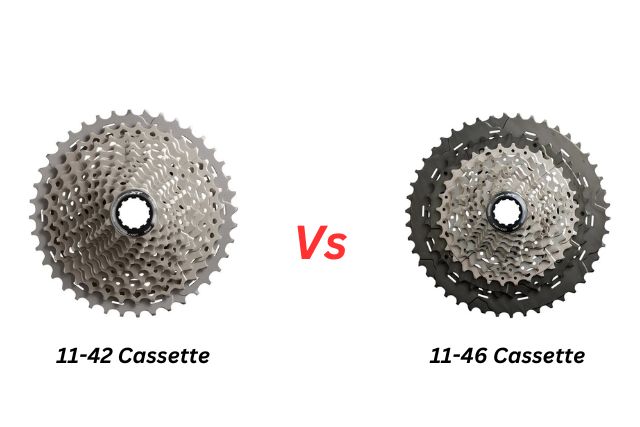
If you are looking for a new cassette for your mountain bike, you might be wondering whether to go for an 11-42 or an 11-46 option. Both of these cassettes have 11 speeds, but they differ in the range of gears they offer.
Below, we will compare the pros and cons of each cassette, and help you decide which one is best for your riding style and terrain.
What is a cassette and why does it matter?
A cassette is the set of sprockets that attach to the rear wheel of your bike. It works together with the chain and the chainring (the front sprocket) to determine how easy or hard it is to pedal.
The number of teeth on each sprocket affects the gear ratio, which is the ratio of the number of teeth on the chainring to the number of teeth on the rear sprocket.
A higher gear ratio means a harder gear, which is faster but requires more effort. A lower gear ratio means an easier gear, which is slower but requires less effort.
The range of gears on a cassette is measured by the difference between the smallest and the largest sprocket.
For example, an 11-42 cassette has a range of 31 teeth, while an 11-46 cassette has a range of 35 teeth. A wider range means more options for adjusting your pedaling speed and effort to suit different terrain and conditions.
11-42 vs 11-46: What are the advantages and disadvantages?
An 11-42 cassette is a common choice for mountain bikers who want a simple and reliable drivetrain. It offers a good balance of speed and climbing ability, without sacrificing too much efficiency or smoothness. It is also lighter and cheaper than an 11-46 cassette, which can be important factors for some riders.
However, an 11-42 cassette may not be enough for riders who face very steep or technical climbs, or who want more flexibility and comfort on long rides. In these cases, an 11-46 cassette may be a better option. It provides a lower gear for easier climbing, as well as a higher gear for faster descending or flat sections. It also reduces the gap between each gear, which can make shifting smoother and more precise.
The main drawbacks of an 11-46 cassette are its weight and cost. It is heavier and more expensive than an 11-42 cassette, which may not be worth it for some riders. It may also require some adjustments to your derailleur or chain length to ensure optimal performance and compatibility.
Read Also: SRAM PG-1210 vs. PG-1230 – Choosing the Ultimate Gear Performance
How to choose the best cassette for you?
The best way to choose between an 11-42 and an 11-46 cassette is to consider your personal preferences and riding goals. Here are some questions to ask yourself:
Terrain
If you ride mostly flat or rolling trails, an 11-42 cassette may be sufficient. If you ride mostly steep or technical trails, an 11-46 cassette may be more suitable.
Distance and Varied Condition
If you ride frequently for long hours or in changing weather or elevation, an 11-46 cassette may give you more versatility and comfort. If you ride occasionally or in consistent conditions, an 11-42 cassette may be enough.
Weight and cost
If you are looking for a light and affordable drivetrain, an 11-42 cassette may be your best bet. If you are willing to spend more money and carry more weight for better performance, an 11-46 cassette may be worth it.
Final Thoughts
The choice between an 11-42 and an 11-46 cassette depends on your personal preference and riding style. There is no right or wrong answer, only what works best for you. Try out both options if possible, and see which one feels better on your bike.
